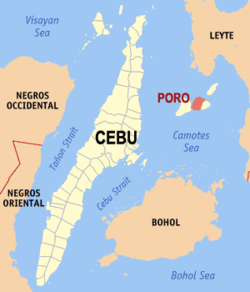Poro, Cebu
It has been suggested that this article be merged into Camotes Islands. (Discuss) Proposed since November 2014. |
Poro | |
|---|---|
 Poro town hall | |
 Map of Cebu with Poro highlighted | |
| Country | Philippines |
| Region | Central Visayas (Region VII) |
| Province | Cebu |
| District | 5th district of Cebu |
| Founded | 17 December 1701 |
| Barangay | 20 (see § Barangays) |
| Government | |
| • Type | Sangguniang Bayan |
| • mayor of Poro[*] | Luciano Rama (BAKUD) |
| • Template:PH wikidata called with unsupported input "leader_title1" | Edgar Rama |
| • Municipal Council | Members |
| Area | |
| • Total | 63.59 km2 (24.55 sq mi) |
| Population (2020 census)[3] | |
| • Total | 26,232 |
| • Density | 410/km2 (1,100/sq mi) |
| • Template:PH wikidata called with unsupported input "population_blank1_title" | Template:PH wikidata called with unsupported input "population_blank1" |
| • Template:PH wikidata called with unsupported input "population_blank2_title" | Template:PH wikidata called with unsupported input "population_blank2" |
| Time zone | UTC+8 (PHT) |
| ZIP code | 6049 |
| IDD : area code | +63 (0)32 |
| Template:PH wikidata called with unsupported input "blank_name_sec1" | Template:PH wikidata called with unsupported input "blank_info_sec1" |
| PSGC | 072238000 |
Poro is a [[Template:PH plural of the Philippines#Income classification|4th municipal income class municipality]] on Camotes Islands in the province of Cebu, Philippines.[2] According to the 2020 census, it has a population of 26,232.[3] Template:PH electorate
Poro, along with the municipality of Tudela, is located on Poro Island of the Camotes Islands.
The patronal feast of Poro is celebrated on the third Friday of January, in honour of the Santo Niño de Cebu.
Barangays
Poro comprises 17 barangays:[2]
Demographics
| Year | Pop. | ±% p.a. |
|---|---|---|
| 1990 | 19,150 | — |
| 1995 | 21,517 | +2.21% |
| 2000 | 21,397 | −0.12% |
| 2007 | 21,529 | +0.08% |
| 2010 | 23,498 | +3.24% |
| Source: National Statistics Office[4][5] | ||
Etymology and languages
The town's name is derived from the Waray-Waray word puro meaning "island". This how Camotes Island is called by Warays and Leyteños. Before the first municipality to be established in Camotes, puro meant the name of all the islands.
Aside from Visayan languages, Filipino, and English, the townsfolk also speak the local Porohanon language. Also known as Camotes Visayan, the language is mutually intelligible with other Visayan languages (e.g. Cebuano) spoken in the rest of the Camotes Islands, Cebu, other parts of the Visayas, and Northern Mindanao.
Porohanon is distinguished by the way the locals substitute /j/ sounds with /ʒ/, for instance Cebuano maayong buntag ("good morning") vocalised as maazong buntag in Porohanon. (Possibly occasions too a handover from the yeísmo phenomenon in Spanish.) Other dialectical variations include the Porohanon ara dira instead of the standard Cebuano na-a diha.
References
- ^ Municipality of Poro | (DILG)
- ^ a b c "Municipal: Poro, Cebu". PSGC Interactive. Quezon City, Philippines: Philippine Statistics Authority. Retrieved 8 January 2016.
- ^ a b Census of Population (2020). "Region VII (Central Visayas)". Total Population by Province, City, Municipality and Barangay. Philippine Statistics Authority. Retrieved 8 July 2021.
- ^ Census of Population and Housing (2010). "Region VII (Central Visayas)" (PDF). Total Population by Province, City, Municipality and Barangay. National Statistics Office. Retrieved 29 June 2016.
- ^ Censuses of Population (1903–2007). "Region VII (Central Visayas)". Table 1. Population Enumerated in Various Censuses by Province/Highly Urbanized City: 1903 to 2007. National Statistics Office.
External links
